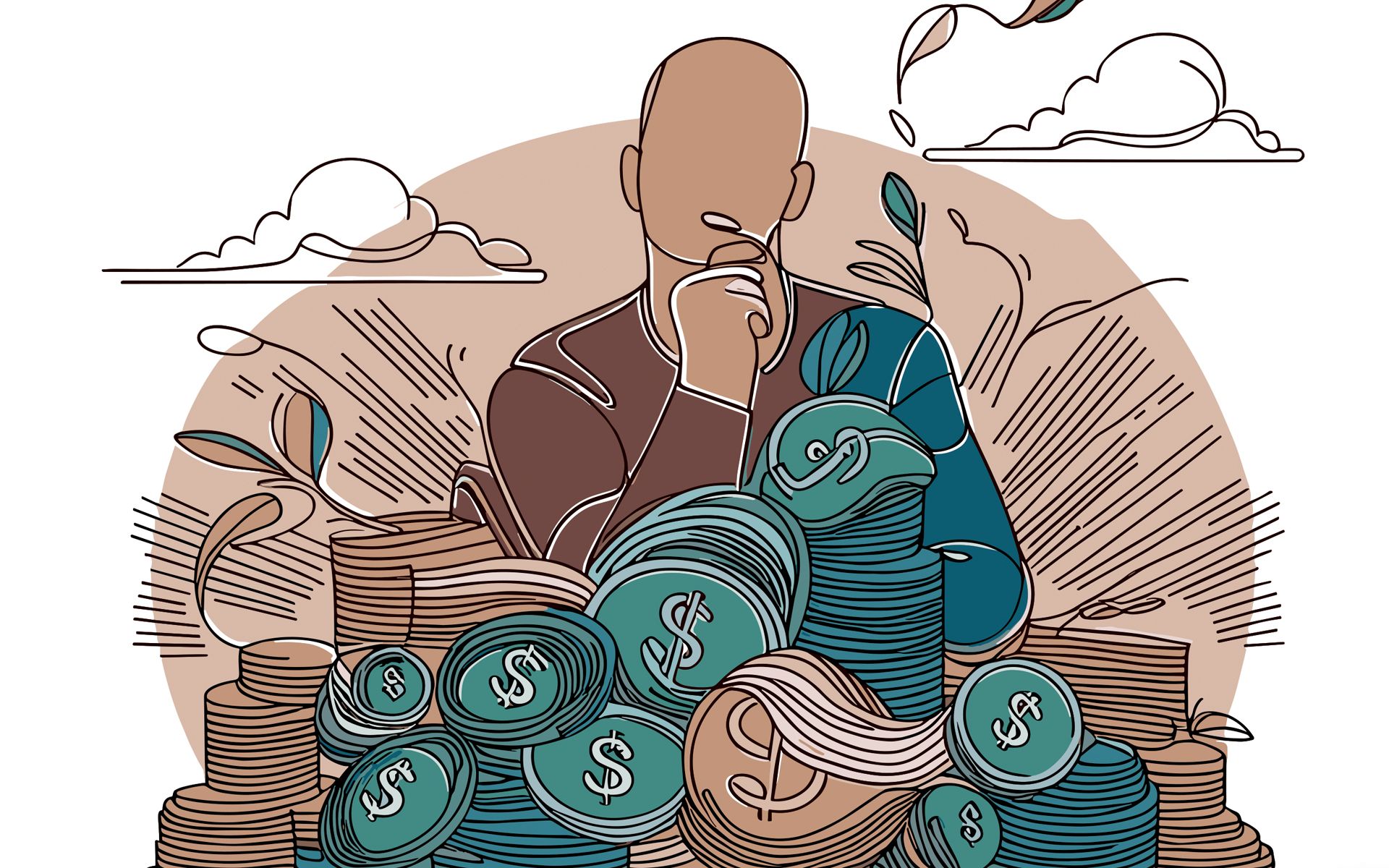Can Money Bring Happiness?

In This Article
-
The belief that financial prosperity automatically equates to happiness suggests that the key to an easy life lies in a substantial bank account or a stroke of inheritance. Although many people have contemplated this idea at some point in their lives, can money buy happiness?
-
The Tower of Hanoi came to be recognized as a mathematical problem towards the end of the 19th century, and since then has expanded the horizons of mathematicians, offering insights into the formula for happiness.
-
According to the Brahma priests, the world's end is expected after approximately six hundred billion seconds, assuming one second is spent on each disc. What the Brahmins mean is that happiness should not be delayed. Terms do not bind it. It is not with money. Happiness is found in the present moment, in working for a meaningful life and being fully engaged in it, right here and right now.
Throughout life, people seek the elusive formula for happiness. The myth of King Midas serves as a poignant illustration that controlling external circumstances does not necessarily lead to a fulfilled existence. Like many individuals, King Midas believed that amassing immense wealth would guarantee his happiness. Thus, he struck a deal with the “gods,” eventually securing the ability to turn everything he touched into gold. It seemed like an extraordinary bargain that would ensure his status as the richest—and, consequently, the happiest—person in the world.
However, poor Midas soon discovered the cruel irony of his wish. As he attempted to eat, the food in his mouth transformed into inedible golden morsels, and the water he tried to drink instantly solidified into unquenchable gold. Trapped in a gilded prison of his own making, King Midas met his untimely demise, surrounded by abundant golden plates and cups. This tale serves as a cautionary reminder that pursuing wealth alone does not lead to genuine happiness or fulfillment.
Unfortunately, for some individuals, the formula for happiness appears deceptively simple: acquiring wealth. The belief that financial prosperity automatically equates to happiness suggests that the key to an easy life lies in a substantial bank account or a stroke of inheritance. It is understandable why such thoughts persist, as many people have contemplated this idea at some point.
In a legend attributed to the ancient Brahma priests, a promise was made to bestow golden discs upon a fortunate individual, enticing people to visit their temples and learn about their religion. The tale goes that within the Brahma temple, there were 64 golden discs arranged on a stake. Adjacent to this pillar, two additional posts stood empty.
The discs varied in size, with the largest positioned at the bottom and each subsequent disc decreasing in size, culminating with the smallest at the top. The smallest disc weighed one kilogram, while the largest weighed 64 kilograms. If one were to possess not just one or two, but the entirety of these golden discs, the cumulative wealth would be staggering—two tons of gold. Imagine the prosperity that could be calculated from such a collection, symbolizing substantial wealth and abundance.
Another perspective could liken it to winning a lottery. Brahma priests had a game. They give the winner of this game a chance to take away these golden discs. The rules of the game were seemingly simple: move the gold discs from the first pole to the third or even the second pole. However, there was a catch—a tiny stipulation with a value potentially worth billions of dollars. When transferring the discs from the first pole to the third, no larger disc could rest on a smaller one. The poles positioned two meters apart. A total of 2080 kilograms of gold discs awaited transfer from the first pole to the other posts. The one who could carry out this task without violating the condition would be the fortunate possessor of the gold. It might sound like a tale from Aladdin's lamp for those unfamiliar with the mathematics behind it.
In reality, the priests had no intention of parting with the gold. The task at hand was not a simple one; it would take generations to complete. Even if descendants continued the mission, moving 64 gold discs to another pole would take an unfathomable amount of time.
Don’t be mistaken in assuming these discs can be easily transferred within a short distance. The minimum number of moves to be made for a legal carry is only 15 for three discs and 1023 for ten discs. No problem so far, but that would suddenly be 1,048,575 for twenty discs. For 64 discs, the number skyrockets to a staggering 18,446,744,073,709,551,615. Even the most optimistic estimate of one second per move, the time required for this task is calculated to be 600 billion years. To put this into perspective, the entire universe is approximately 13.7 billion years old, underscoring the staggering magnitude of time involved.
What the priests might be implying is the profound extent of human greed for wealth, a desire that won't even endure for a billionth of the time required to complete the replacement of the 64 discs. Alternatively, could they be suggesting that life is fleeting and should not be preoccupied with trivial pursuits? It's unclear, perhaps even a ploy to entice people into their temples. However, one undeniable fact remains: mathematical applications permeate various aspects of life, and a knowledge of mathematics proves essential.
Think about it: would someone with the ability to play the game by the rules and calculate from the outset that taking all the gold and leaving is impossible ever visit such a place? Perhaps, driven by curiosity. Nevertheless, this game, which is called the Tower of Hanoi, came to be recognized as a mathematical problem towards the end of the 19th century, and since then has expanded the horizons of mathematicians, offering insights into both gold and the formula for happiness. In the Tower of Hanoi problem, transferring three discs from the first stick to the third necessitates at least seven moves. The number of moves increases to 15 for four discs and 31 for five discs, following the pattern. This leads to the formula for the minimum transfer number: 2n–1, where “n” is the number of discs. Applying this formula to the 64 gold discs mentioned in the legend, the number of moves is calculated as 264–1. Interestingly, the same formula is employed to determine the number of subsets for clusters at the middle-high school level, showcasing the ubiquity and versatility of mathematical principles.
One of the most notable contributions of this problem was its role in discovering the largest known prime number until 1951. At that time, the record-holder was the number 2127–1. Before computers took center stage in scientific endeavors, it made sense to tackle this challenge manually, moving 127 discs to calculate the number of moves required to unveil the most significant known prime number! Beyond this, there's a surprising revelation when we articulate the movement of 5 discs: from the smallest disc to the largest one, it becomes an intriguing formulation, and a sequence appears.
For n=1, S1=1
For n=2, S2= 1, 2, 1
For n=3, S3=1, 2, 1, 3, 1, 2, 1
For n=4, S4= 1, 2, 1, 3, 1, 2, 1, 4, 1, 2, 1, 3, 1, 2, 1
For n=5, S5=1, 2, 1, 3, 1, 2, 1, 4, 1, 2, 1, 3, 1, 2, 1, 5, 1, 2, 1, 3, 1, 2, 4, 1, 2, 1, 3, 1, 2, 1
The sequence here is remarkable. The journey to the largest disc entails an incremental progression from 1, 2, to 1, followed by a return in the same sequence, concluding with a decrease by one. The first move is significant in the Tower of Hanoi. The algorithmic structure of the tower of Hanoi is used as explanatory material in computer coding lessons. The right start is the most significant factor in completing the game with minimum moves. However, the conclusion of the legend is not particularly optimistic. Even if all 64 discs are successfully transferred, the outcome is not a joyous one, as the passage of time heralds the approaching end of the world. Whosoever places the final gold disc on the third pillar will not benefit from the wealth either, as it is believed that chaos will ensue. According to the Brahma priests, the world's end is expected after approximately six hundred billion seconds, assuming one second is spent on each disc. What the Brahmins mean is that happiness should not be delayed. Terms do not bind it. It is not with money. Happiness is found in the present moment, in working for a meaningful life and being fully engaged in it, right here and right now. Also, studies show that happiness is a function of reality minus expectations. While some studies show income is correlated with well-being and happiness, other research, such as the one conducted by Nobel-prize-winning psychologist Daniel Kahneman, shows that above a certain threshold, somewhere between $75K and $90K per year, minor adjustments may be needed to account for variations in location or other factors [1].
On the other hand, additional income beyond this threshold is not correlated with increased happiness or well-being. Emotional well-being appears to peak after the $75K mark. In a study conducted across 164 countries, involving 1.7 million participants, individuals were questioned about their purchasing power, life satisfaction, and overall well-being. The findings revealed that people within the income range of $75,000 to $95,000 generally reported the highest levels of happiness.
Contrary to popular belief, those who earn more than $95K experience varying levels of happiness. Exploring the mathematical relationship between wealth and happiness, it appears to exhibit an exponential and parabolic structure. Money can't always buy happiness. If we visualize a curved design, with money on the X-axis and happiness on the Y-axis, and the graph starting from the origin point (0,0), we observe an interesting relationship. Initially, the graph suggests a correlation between money and happiness, echoing the common belief that without money, there is no happiness—a notion applicable in many contexts but not universally true, such as in the village of Piraha in the Amazon jungle.
As depicted in the chart, the association between money and happiness is not a straight line; it follows a curvilinear pattern. The more money one has, the higher the reported happiness, but this increase is not constant. Instead, it peaks and then starts to decline after a certain point. Research has identified the peak of this curve as an annual income of $95,000. It's noteworthy that the level of happiness experiences only marginal improvement beyond $65,000, and once the maximum point is reached, further increases in income can lead to a decrease in happiness.
This phenomenon underscores the idea that beyond a certain threshold, additional money does not contribute positively to happiness; instead, it may have the opposite effect. This aligns with the saying, "Do you have money? Then you have a big problem!" as the graph reveals a diminishing return on happiness after reaching a specific income level.
However, a recent 2021 study of over one million participants challenges this notion, indicating that there might not be a definitive inflection point beyond which increased wealth does not equate to heightened happiness, at least not until an annual salary of $500,000. This study employed a more comprehensive well-being assessment, focusing on participants' current emotional state rather than relying on recollections of their past experiences over weeks, months, or years. According to this real-time evaluation, individuals with significantly higher incomes reported experiencing elevated levels of happiness [2].
On the flip side, the geographical location where even lottery winners reside can significantly influence the long-term effects of their newfound wealth on psychological well-being. Factors such as local culture, social support networks, access to resources and services, and community norms all play a role in shaping how individuals perceive and experience their lottery windfall. Moreover, the cost of living, economic opportunities, and lifestyle expectations in different locations contribute to the overall impact of lottery winnings on psychological well-being over time.
A notable study from Sweden delves into this phenomenon, examining how lottery wins affect individuals' lives. Remarkably, even years after winning, the study reveals that lottery winners consistently report higher life satisfaction and mental well-being. They also demonstrate an enhanced ability to navigate challenges such as divorce, illness, and solitude when compared to individuals who did not win the lottery. The possession of a substantial sum of money significantly alleviated the difficulties associated with these life events for the winners [3].
While the impact of lottery winnings on psychological well-being is influenced by various factors, it's crucial to recognize that happiness is a complex and multifaceted concept. Beyond financial considerations, individual satisfaction is shaped by the broader context of one's life and surroundings. The Sweden study on lottery winners serves as a compelling illustration. Despite the evident positive effects on life satisfaction and mental well-being among winners, it underscores that true happiness encompasses more than just monetary gains. The ability to navigate life's challenges, build meaningful connections, and find fulfillment in personal pursuits are integral components of a contented life. Therefore, while financial prosperity can certainly alleviate certain hardships, the broader understanding of happiness extends beyond the confines of wealth.
In summary, the findings in these studies show that happiness is not necessarily linked to worldly, materialistic wealth. Rather, the financial means at one’s disposal can yield varying levels of satisfaction. Interestingly, the results also reveal that individuals in lower-income groups tend to excel at discovering ways to derive meaning from life, find joy, and cultivate happiness even within the constraints of their limited conditions. This suggests that the pursuit and attainment of happiness are complex and can be achieved through diverse avenues, transcending the mere accumulation of wealth.
References
- High income improves evaluation of life but not emotional well-being, Daniel Kahneman and Angus Deaton, September 7, 2010,107 (38) 16489-16493, https://doi.org/10.1073/pnas.1011492107
- “Experienced well-being rises with income, even above $75,000 per year.” Matthew A. Killingsworth, PNAS, January 18, 2021, 118 (4) e2016976118 https://doi.org/10.1073/pnas.2016976118
- “Long-Run Effects of Lottery Wealth on Psychological Well-Being,” Erik Lindqvist, Robert Östling, David Cesarini,The Review of Economic Studies, Volume 87, Issue 6, November 2020, Pages 2703–2726, https://doi.org/10.1093/restud/rdaa006








